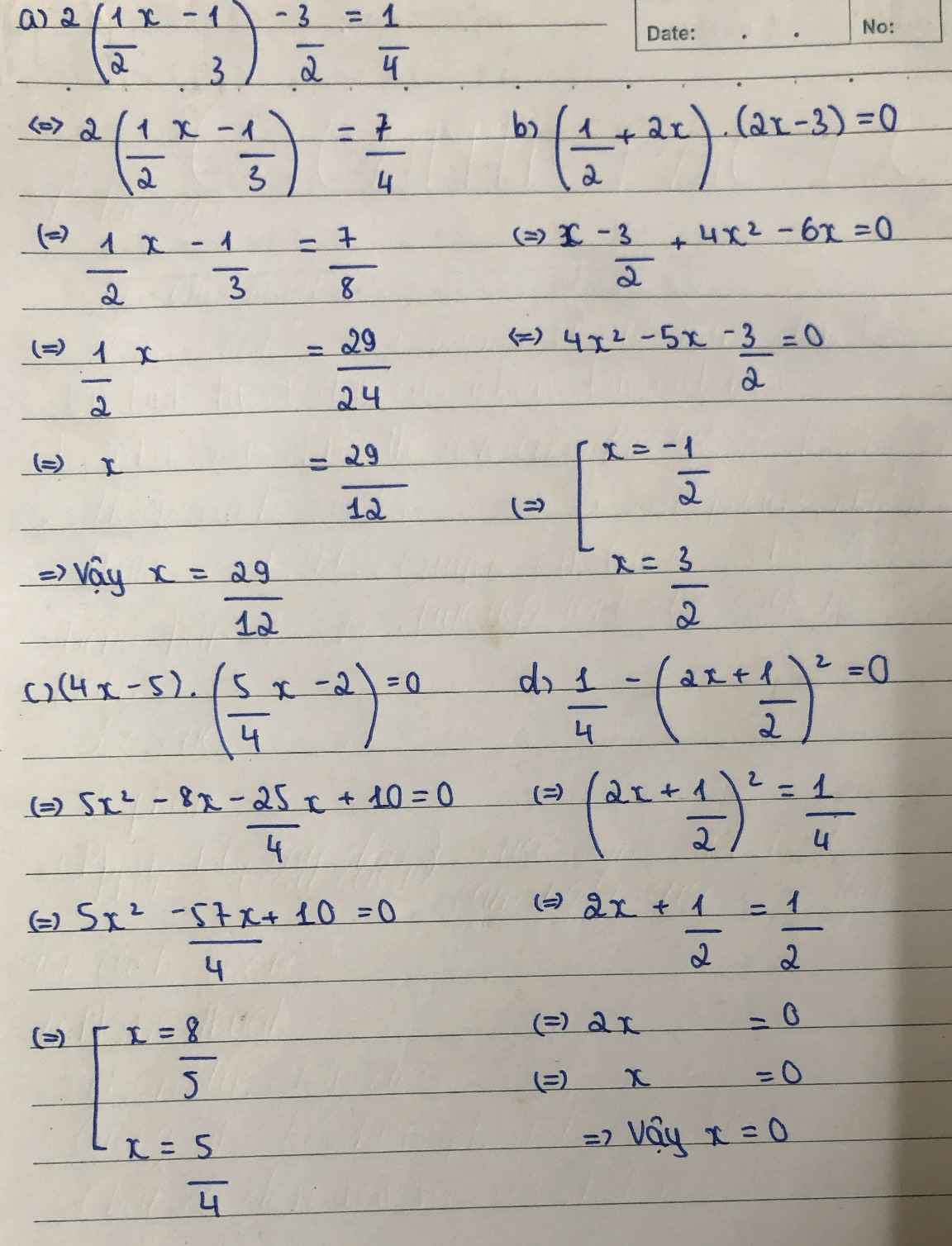
Hãy nhập câu hỏi của bạn vào đây, nếu là tài khoản VIP, bạn sẽ được ưu tiên trả lời.



1: =>x+1/2=0 hoặc 2/3-2x=0
=>x=-1/2 hoặc x=1/3
2: =>7/6x=5/2:3,75=2/3
=>x=2/3:7/6=2/3*6/7=12/21=4/7
3: =>2x-3=0 hoặc 6-2x=0
=>x=3 hoặc x=3/2
4: =>-5x-1-1/2x+1/3=3/2x-5/6
=>-11/2x-3/2x=-5/6-1/3+1
=>-7x=-1/6
=>x=1/42

Lời giải:
$2^{x-1}+2^x+2^{x+1}=112$
$2^{x-1}+2^{x-1}.2+2^{x-1}.2^2=112$
$2^{x-1}(1+2+2^2)=112$
$2^{x-1}.7=112$
$2^{x-1}=112:7=16=2^4$
$\Rightarrow x-1=4$
$\Rightarrow x=5$


Lời giải:
$2^x+2^{x+1}+2^{x+2}+....+2^{x+2020}=2^{x+2024}-8$
$2^x(1+2+2^2+...+2^{2020})=2^{x+2024}-8$
$2^x(2+2^2+2^3+...+2^{2021})=2^{x+2025}-16$
$\Rightarrow 2^x(2+2^2+2^3+...+2^{2021})- (2^x(1+2+2^2+...+2^{2020}))=2^{x+2025}-16-(2^{x+2024}-8)$
$\Rightarrow 2^x(2^{2021}-1)=2^{x+2025}-2^{x+2024}-8$
$\Rightarrow 2^x(2^{2021}-1)=2^{x+2024}(2-1)-8$
$\Rightarrow 2^{x+2021}-2^x=2^{3+2021}-2^3$
$\Rightarrow x=3$


\(\dfrac{2x}{15}+\dfrac{2x}{35}+\dfrac{2x}{63}+...+\dfrac{2x}{195}=\dfrac{4}{5}\\ x\cdot\left(\dfrac{2}{15}+\dfrac{2}{35}+\dfrac{2}{63}+...+\dfrac{2}{195}\right)=\dfrac{4}{5}\\ x\cdot\left(\dfrac{2}{3\cdot5}+\dfrac{2}{5\cdot7}+\dfrac{2}{7\cdot9}+...+\dfrac{2}{13\cdot15}\right)=\dfrac{4}{5}\\ x\cdot\left(\dfrac{1}{3}-\dfrac{1}{5}+\dfrac{1}{5}-\dfrac{1}{7}+\dfrac{1}{7}-\dfrac{1}{9}+...+\dfrac{1}{13}-\dfrac{1}{15}\right)=\dfrac{4}{5}\\ x\cdot\left(\dfrac{1}{3}-\dfrac{1}{15}\right)=\dfrac{4}{5}\\ x\cdot\dfrac{4}{15}=\dfrac{4}{5}\\ x=\dfrac{4}{5}:\dfrac{4}{15}\\ x=3\)
Gọi \(D=\dfrac{1}{2}-\dfrac{1}{4}+\dfrac{1}{8}-\dfrac{1}{16}+\dfrac{1}{32}-\dfrac{1}{64}\)
\(2D=1-\dfrac{1}{2}+\dfrac{1}{4}-\dfrac{1}{8}+\dfrac{1}{16}-\dfrac{1}{32}\\ 2D+D=\left(1-\dfrac{1}{2}+\dfrac{1}{4}-\dfrac{1}{8}+\dfrac{1}{16}-\dfrac{1}{32}\right)+\left(\dfrac{1}{2}-\dfrac{1}{4}+\dfrac{1}{8}-\dfrac{1}{16}+\dfrac{1}{32}-\dfrac{1}{64}\right)\\ 3D=1-\dfrac{1}{2}+\dfrac{1}{4}-\dfrac{1}{8}+\dfrac{1}{16}-\dfrac{1}{32}+\dfrac{1}{2}-\dfrac{1}{4}+\dfrac{1}{8}-\dfrac{1}{16}+\dfrac{1}{32}-\dfrac{1}{64}\\ 3D=1-\dfrac{1}{64}< 1\\ \Rightarrow D=\dfrac{1-\dfrac{1}{64}}{3}< \dfrac{1}{3}\)
Vậy \(\dfrac{1}{2}-\dfrac{1}{4}+\dfrac{1}{8}-\dfrac{1}{16}+\dfrac{1}{32}-\dfrac{1}{64}< \dfrac{1}{3}\)
